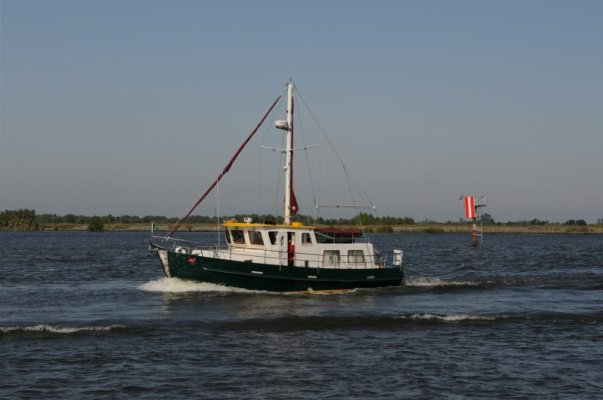Nomad Willy
Guru
Our trawler engines are 1500lbs. Transmissions and accessories like heat exchangers and engine mounts ect bumps the weight to about 2300lbs. Extra fuel and tanks makes the twins much or considerably heavier.
Keith,
Boat design often has a range of acceptable weights, volumes ect ect. When it comes to weight the placement and amount of weight has a profound effect on how the boat behaves on lumpy seas. I can’t imagine a GB 36 being too light but becoming too heavy could easily happen. Sure the designer took the weights into account but I’m saying it could be at the higher end of the acceptable range. This could be arrived at from weights and their placement. A boat w too much weight at the bow and stern would respond to the helm .. in a word .. terribly or scary w stern seas. A well balanced boat is a joy comparatively speaking.
And I don’t know who establishes the essential ranges of design. Perhaps there are no numerical guides and it’s just a guess done by the NA. Maybe he (or she) has has graduated from the boat design school “Westlawn” .. or some school/academy or whatever.
All the boat builders dropped down to one of the FL’s or Perkins engines. But some were installed further aft than what was done or what usually is done. In most of these matters there’s no black and white .. but a range of grey.
Koliver wrote;
“What is your take on a pair of 80 hp v a single 160 hp, approx same total weight?”
Now this is a genuine what is better a single or a twin question. I would guess two 80hp engines would weigh close to the same. So no weight consideration for me to comment on. I once saw a GB 36 w two JH Yanmars (55hp each) on YW. It sold fast. I was shopping then but the boat was on the east coast. Almost the same hp. For me this would almost be the Ideal trawler. I like it a lot.
Now if the question was about a GB 36 w two JD engines or one Yanmar ?? But two JD 80’s would be a popular choice among TF members.
Keith,
Boat design often has a range of acceptable weights, volumes ect ect. When it comes to weight the placement and amount of weight has a profound effect on how the boat behaves on lumpy seas. I can’t imagine a GB 36 being too light but becoming too heavy could easily happen. Sure the designer took the weights into account but I’m saying it could be at the higher end of the acceptable range. This could be arrived at from weights and their placement. A boat w too much weight at the bow and stern would respond to the helm .. in a word .. terribly or scary w stern seas. A well balanced boat is a joy comparatively speaking.
And I don’t know who establishes the essential ranges of design. Perhaps there are no numerical guides and it’s just a guess done by the NA. Maybe he (or she) has has graduated from the boat design school “Westlawn” .. or some school/academy or whatever.
All the boat builders dropped down to one of the FL’s or Perkins engines. But some were installed further aft than what was done or what usually is done. In most of these matters there’s no black and white .. but a range of grey.
Koliver wrote;
“What is your take on a pair of 80 hp v a single 160 hp, approx same total weight?”
Now this is a genuine what is better a single or a twin question. I would guess two 80hp engines would weigh close to the same. So no weight consideration for me to comment on. I once saw a GB 36 w two JH Yanmars (55hp each) on YW. It sold fast. I was shopping then but the boat was on the east coast. Almost the same hp. For me this would almost be the Ideal trawler. I like it a lot.
Now if the question was about a GB 36 w two JD engines or one Yanmar ?? But two JD 80’s would be a popular choice among TF members.



 what is wrong with my math?
what is wrong with my math?